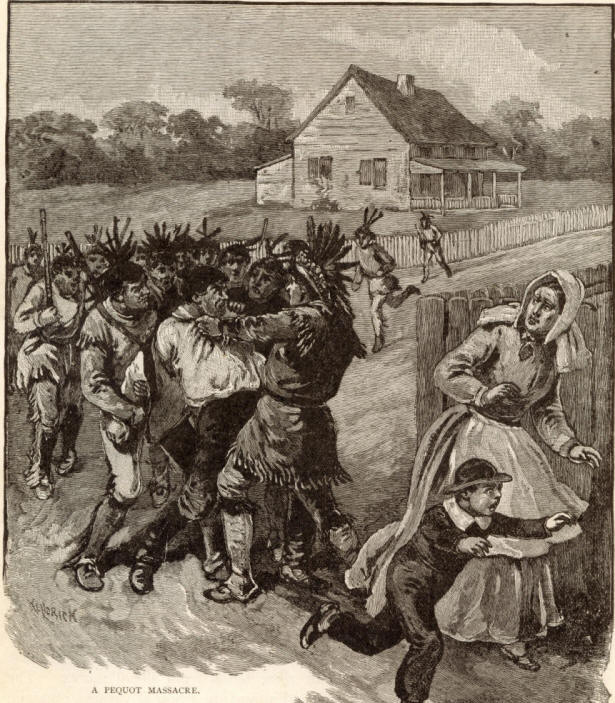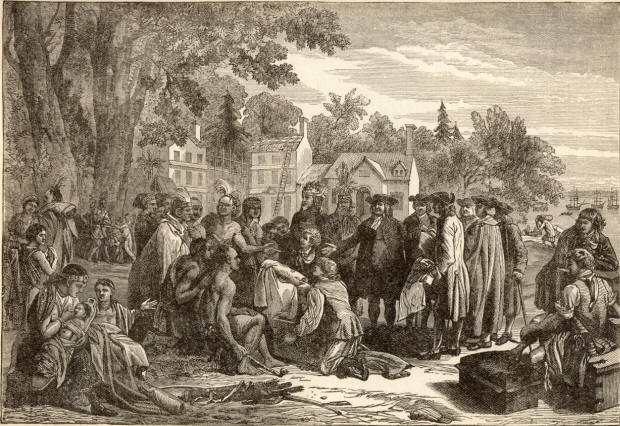Colonization of America
|
|
This Site:
|
II. Settlement of St. Augustine by the Spaniards III. Settlement of Roanoke Island IV. French Colonization Efforts V. English Colonization Efforts VII. Bacon's Rebellion VIII. The Pilgrims Arrive on the Mayflower X. Henry Hudson XI. The Dutch Lose New Amsterdam
SETTLING THE NEW COUNTRY.A FEW years cover the beginnings of colonization in America. Great impulses seem to be epidemic. The variety of causes which led to the planting of the American colonies became operative under diverse national and race conditions, so that they appear in history as the synchronous details of a common plan. As the reader follows these pages and appropriates all the wonderful and inspiring details of this unequaled record of four centuries, his interest will deepen and his amazement will keep pace with his interest. Finding a barren shore, broken only by the roar of the surf, the cries of birds and animals, and the whoop of the Indian, you will discover that civilization has followed the sun until the two oceans have met connected by an unbroken tide of humanity ebbing and flowing from the Atlantic to the Pacific. A minute account of the social and political situations in the various kingdoms of Europe during the sixteenth century is not within the scope of this work, but it will be well to make a very brief statement of the questions that agitated Christendom at this time, and to notice the temper of the times. Cupidity and a love of adventure led the Spaniard to the conquest of the New World. Spain was then paramount in Europe, most powerful as well as most Catholic; and the controlling motive of her sovereigns was conquest. It was not reformation nor revolution that sent her people over seas, but the love of power and wealth. In France, on the contrary, the spirit of revolt against established dogmas had led to persecution, so that the Huguenots were glad to find an asylum in the wilderness of the New World. Under these conditions the first colonies were attempted in the middle of the sixteenth century. Thirty years later a second planting, more general and more effectual, was begun. At that time Protestant England had a Catholic king. Henry of Navarre was upon the throne of France, which he had gained by his apostacy. Holland, the mighty little republic, was, under the wise leadership of John of Barneveld and the States General, keeping Catholic Europe in check. Spain had been for years planning the conquest of England "as a stepping-stone to the recovery of the Netherlands." It will be seen that the very causes which led emigrants to colonize the new continent forbade friendship or common interests between those of different races, the animosities of the Old World being very carefully transplanted to the new along with other possessions. Settlement of St. AugustineFrance made the first attempt at colonization in 1555. One of the leaders in the enterprise was Coligny, the Huguenott admiral; John Ribault and Laudoniere were masters of successive expeditions, seeking first the Florida coast and afterward establishing a settlement in Carolina. The French have seldom made good colonists, and those of Carolina were no exception to the general rule. It is probable that their quarrelsome dispositions would have destroyed them in time had not the Spanish claimants of the country, led by Menendez, hastened the event. This expedition of the Spaniards was not only noteworthy because of the cruel massacre of Ribault and his Huguenot followers, but also as the occasion of the founding of the most ancient of North American cities, St. Augustine. This occurred in 1564. The settlement of St. Augustine was followed by a hiatus in which nothing was done toward the colonization of America. This was due to the great religious war which was then raging in Europe. But in the interval the missionary expeditions of the Spanish Franciscans, Ruyz and Espejio, in 1582, resulted in the building of Santa Fe in New Mexico. There had also been the establishment by adventurers of various fishing and trading stations, notably the one on the island of New Foundland.
Indian Attack at BrookfieldDuring the interval England had been steadily growing as a marine power, and her navigators had directed men's eyes anew towards the land where so many of their countrymen should find refuge. Finally Raleigh, following in the footsteps of his famous half-brother, Sir Humphrey Gilbert, obtained a patent from Queen Elizabeth, by the terms of which he should become proprietor of six hundred miles radially from any point which he might discover or take, provided he did not encroach upon territory otherwise granted by any Christian sovereign. As an auxiliary to this grant the queen gave her favorite a monopoly of the sale of sweet wines, by the profits of which business he was soon enabled to fit out what was known as the Lane expedition, that sailed under the command of Grenville in 1585, and landed at Roanoke, in Virginia. THE ROANOKE COLONY.Grenville's first act upon landing was to rouse
the animosity of the Indians by burning one of their villages and
some cornfields, after which he left Lane, the Governor, with only
an hundred and ten men and returned to England. Scarcity of
provisions, a constant quarrel with their Indian neighbors, and a
general feeling of discouragement led these first
Virginia colonists to hail the navigator,
Drake, who appeared on the coast a few months after, as a deliverer,
and rejecting his offers of a vessel and provisions, they insisted
upon returning with him to the mother country. Their departure was
almost immediately followed by the arrival of reinforcements and
supplies from Raleigh, brought by Grenville, who, when he found the
place deserted, left fifteen, men to guard it and himself proceeded
southward to pillage the Spaniards of the West Indies. White arrived in England to find the nation preparing for a struggle with Spain. His return to the colonies was therefore delayed. Raleigh, finding himself impoverished by the former expeditions, which had cost him $200,000, made an assignment, under his patent, to a company which included White and one Thomas Smith. A new fleet was procured, though with considerable trouble, and again the adventurers sought the Virginia coast, in 1590, only to find that the unfortunate settlement of three years before had been utterly wiped out of existence. So ended the first English attempt to settle America. THE FRENCH ATTEMPT COLONIZATION.About the same time de La Roche, a Marquis of Brittany, obtained from Henry IV of France a commission to take Canada. His company consisted largely of convicts and criminals. Following him came Chauvin de Chatte, but he accomplished little of permanent value. For some years following the last attempt of Raleigh to colonize Virginia, a desultory trade with the Indians of the coast was pursued, the staples being sassafras, tobacco, and furs. Richard Hakluyt, one of the assignees of Raleigh, was most active in promoting this traffic; and among others employed was Bartholomew Gosnold, who, taking a more northerly course than the one usually followed, discovered Cape Cod, Nantucket, and Martha's Vineyard, and the Elizabeth Islands, Following Gosnold, in 1603, came Martin Pring, exploring Penobscot Bay, tracing the coast thence as far south as Martha's Vineyard. A French grant of the same year gave to Sieur de Monts, a Protestant, the whole of North America between the 40th and 46th parallels of north latitude. This domain was named Acadie. De Monts looked for a monopoly of the fur trade on what is now the New England and Canadian coast. His Lieutenants in the expeditions which he soon commenced, were Poutrincourt and Champlain, of whom the latter became famous for several discoveries, but in particular for the lake which bears his name. So it will be noticed that both the French and English were stretching out their hands to acquire the same territory. De Monts and Champlain settled their colony at St. Croix, but soon shifted, trying various points along the coast, and even attempted to inhabit Cape Cod, but were driven away by the natives. At last they transferred the settlement to Port Royal (Annapolis), where it endured for about a year. De Monts' commission or patent was recalled in 1606, and but a little while previously Raleigh's grant was forfeited by attainder, he having been imprisoned by King James on a charge of treason. The frequent failures to effect a permanent settlement in America did not discourage adventurers, whose desire to possess the new world seemed to grow stronger every year. Soon two new companies were incorporated under Royal charter, to be known as the First and Second Colonies of Virginia. The former was composed of London men, and the latter of Plymouth people principally. The charter authorized the Companies
to recruit and ship colonists, to engage in mining operations and
the like, and to trade; their exports to be free of duties for seven
years and duties to be levied by themselves for their own use for a
period of twenty years. They might also coin money and protect
themselves against invasion. Their lands were held of the King.
Hardly had the charter been granted when James
began to make regulations or instructions for the government of the
colonies, which gave a shadow of self rule, established the church
of England, and decreed, among other things, that the fruits of
their industries were to be held in common stock by the colonists
for five years. These instructions, along with the names of the
"Council" appointed by James for the government of the settlement,
were carried, sealed in a tin box, by
Captain Christopher
Newport, who commanded the three vessels which constituted the
initial venture of the London Company.
An ill chosen band landed at last at Old Point Comfort, after a
stormy voyage. Of the one hundred and five men there were
forty-three "gentlemen", twelve laborers, half a dozen mechanics and
a number of soldiers. These quarreled during the voyage, so that
John Smith, who it
afterward appeared was one of the Councilors appointed by the Crown,
entered Chesapeake Bay a prisoner, charged with conspiracy. As might
have been expected, this company did not fare well. They were
consumed with laziness and jealousy; there were cabals in the
council and bickerings outside of it. Repeatedly the men tried to
desert; deaths were frequent and want stared them in the face.
During this time it is hardly too much to say that the energy and
wisdom of John Smith held the discouraged adventurers together. New
arrivals of the same sort as the first added to, rather than
diminished, the difficulties of the situation, so that at length
Smith wrote that thirty workmen would be worth more than a thousand
of such people as were being sent out. Not till the third lot of
emigrants arrived did any women visit the new settlement, and then
only two. The Indians became more and more troublesome, and the
London Company, dissatisfied at
receiving no returns from their investment, threatened to leave the
settlers to shift for themselves.
These earlier days in Virginia, while
historically valuable only as a warning, have afforded an unusual
share of romance, much of which centers about the unromantic name of
Smith. Clearing away the romance, and allowing all that
is necessary to one who is so often the hero of his own narrative,
it may not be uninteresting to briefly note some of the unquestioned
services that John Smith performed for the struggling colony. We
have seen how he arrived under suspicion and arrest, landing on the
site of the little settlement which was destined to owe so much to
him, like a felon. The opening of the hitherto secret instructions
given under the broad seal of England, disclosed the fact that he
was one of the Councillors named in that document. But it was his
own clear head and strong courage rather than any royal appointment
which won him the leadership in the affairs of the settlement. The
quarrels and incompetency of the two governors, Wingfield and
Ratcliffe, acted as a foil to display his superior quality. Although
believing to the full in the common creed of his time, that the
inducements of wealth were the only ones which would lead men to
sacrifice home and comfort for the wilderness, yet he evinced a
genius for hard work and a contempt for hard knocks worthy of a
nobler purpose. It was in his first extended exploration of the
Chickahominy that the Pocahontas
affair is supposed to have occurred. That he was taken prisoner
then, and by some means escaped from his captors, is undeniable. And
in passing, we may observe the curious misapprehension regarding the
width of the American continent which Smith's journey up the
Chickahominy betrayed. He was actually looking for the Pacific
ocean! In keeping with this error is that clause in the American
charters which would make the land grants like long, narrow ribbons
reaching from ocean to ocean. In 1608 Smith ascended Chesapeake Bay and
explored the larger rivers emptying into it. In an open boat, he
traveled over two thousand miles on freshwater. He parleyed with the
Mohawks, and returned to subdue the much more unmanageable colonists
at Jamestown. When the half-starved and
wholly discouraged adventurers became mutinous, his methods of
dealing with them were dictatorial and effectual. As already stated, Smith, upon his departure from
Virginia, left nearly five hundred people
there. In six months there remained only sixty. Many had died, some
thirty or more seized a small vessel and sailed South on a piratical
expedition, and a number wandered into the Indian country and never
came back. Sick and disheartened, the remainder resolved to abandon
Virginia and seek Newfoundland. Indeed, they had actually made all
preparations and were starting upon their voyage, when they were met
by the new governor from England, Lord
De La War, with ships, recruits and provisions. The charter under which De La War assumed the
government of Virginia was sufficiently liberal. It was that granted
to Raleigh. But in the years that followed, the colony began to be
prosperous and to excite the jealousy of the king; the same base,
faithless king that had beheaded Raleigh. James began to conspire
against the Virginia charter. It was too liberal: he dreaded the
power it conferred. By 1620 colonists were pouring into Jamestown at
the rate of a thousand a year, and thence being distributed through
the country. To try to condense the early colonial history of
Virginia to the limits of our space would result in a bare recital
of names, or a repetition of the narrative of ignorance, vice, and
want, occasionally relieved by some deed of devotion or daring. At
first, in spite of the liberal provisions of the charter, the
conditions were, to a large extent, those of vassalage. In 1623
James ordered the Company's directors to surrender their charter, a
demand which they naturally refused. He then brought suit against
the Company, seized their papers so that they should have no
defense, and finally, through foul means obtained a decision
dissolving the Company. After that the government of the colony
consisted in a governor and two councils, one of which sat in
Virginia and the other in London. The governor and councils were by
royal appointment. Here we must be allowed to digress a little, to
give the part played by one
Nathaniel Bacon in the
affairs of Virginia. It was the year 1676, when Bacon became the
leader of a popular movement instituted by the people of Kent
County, whose purpose was twofold; first, to protect themselves
against the Indians, which the Government failed to do; and,
secondly, to resist the unjust taxes and the oppressive laws enacted
by the existing legislative assembly, and also to recover their
liberties lost under the arbitrary proceedings of
Sir William Berkeley,
then Governor Bacon, a popular, quiet man, who had come over from
England a year before, was selected as their leader by the people,
who, enrolling themselves 300 strong, were led by Bacon against the
Indians. Bacon's success increased the jealousy of Sir William, who,
because of Bacon's irregular leadership, he having no proper
commission, proclaimed Bacon a rebel. Finally, the people rose en
masse, and demanded the dissolution of the old assembly, whose acts
had caused so much trouble. Berkeley was forced to yield, and a new
assembly was elected, who, condoning Bacon's irregular leadership,
promised him a regular commission as General. This commission
Berkeley refused to issue, whereupon Bacon, assembling his forces,
at the head of 500 men, appeared before Berkeley and demanded his
commission, which Berkeley, who was a real coward, made haste to
grant. But, as if repenting of his concession, Berkeley determined
to oppose Bacon by force. In this he was unsuccessful, and in July
of that year, Bacon entered Jamestown, the Capital, and burned the
town. A little later, in October, Bacon died, and with him the
"rebellion," or "popular uprising" as it had been variously called,
subsided. Shortly afterward Berkeley was removed, for oppression and
cruelty -a cruel, bloodthirsty man he was and, sailing for England,
died soon after his arrival, and the world's population of
scoundrels was lessened by just one.
While the curious mixture of cavalier and
criminal was working out the early destinies of Virginia, a deeply
religious element in Nottinghamshire and Yorkshire, England, were
being educated by adversity for an adventure of a very different
sort. At Scrooby, in 1606, a congregation of Separatists or
Bronnists, who were ultra
Puritans, used to meet secretly for worship at the house of
their elder, William
Brewster. King James, like most renegades, was a good
persecutor, and he finally drove the Scrooby church to flee. Led by
their pastor, that wisest and gentlest of the Puritans,
John Robinson, the
little company escaped to Holland. The history of their ten years of
sorrow and hardship in Amsterdam and Leyden is too well known to
require repetition here. It is impossible to overestimate the
influence of such a man as Robinson, or to question the permanency
of the impression which his character and teaching made upon his
flock. Procuring a patent from the London company, the
Scrooby-Leyden Separatists prepared for their adventure. Only about
half the Holland company could get ready, and it fell to the
pastor's lot to stay with those who were left behind. Embarking on
the Speedwell, at Delft Haven, the colonists bade good-by to their
friends and directed their course to England, where they were joined
by the Mayflower. The Speedwell was found to be unseaworthy, so at
length most of her passengers were transferred to the Mayflower,
which proceeded on the voyage. To those who know how small a vessel
of i80 tons is, the fact that one hundred souls, besides the crew,
were upon a stormy ocean in her for more than sixty days, will be as
eloquent as any description of their discomforts could be. The
objective point was far to the southward of the land that they
finally fell upon, which was not within the limits of their patent
from the Virginia Company. But they dropped anchor in Cape Cod
harbor, sick and weary with the voyage, and landed, giving thanks
for their deliverance. With wisdom and frugality the plans for the
home in the wilderness were made. Being too far North to be bound or protected by
the provisions of the Virginia charter, the
Pilgrims, as they called
themselves, made a compact which was mutually protective. The terms
of the contract foreshadowed republican institutions. Thus in
character, purpose and outward surroundings the Puritan of
Plymouth and the Cavalier of
Jamestown differed essentially. The after development of the two
settlements followed logically along these lines, emphasizing these
differences.
The second New England colony was that of
Massachusetts Bay, which was sent
out by a company provided with a charter very much like that of
Virginia. The provisions of this patent allowed for the appointment
of officers by the company, but it was not stated where the
headquarters of the company were to be. This important oversight
allowed the transplanting of the company, with officers, elective
power, and other democratic rights, to New
England. The company, which pretended to be a commercial
organization, was really composed of
Puritans, who, though not
Separatists, were strict to the point of fanaticism. The leader of
the first emigrants was John Endicott. His followers numbered less
than a hundred souls, with which little force he planted
Salem. The Salem colonists,
though they had known less persecution and hardship than those of
Plymouth, or perhaps for that reason, yet were more intolerant and
Quixotic in their rules for self government, in social observances,
and especially in their dealings with people of other religious
sects. The transference of the government of the company, together
with the addition of over eight hundred new colonists, was made in
1630.
The war
with Philip, Massasoit's
son, occurred in 1675, when the colony was stronger and better able
to bear the tax upon its vigor, but during the year in which it
lasted the settlements were frightfully crippled. Six hundred houses
had been burned, the fighting force of the English had been
decimated, and the fruits of years of labor wasted. The whole
difficulty arose from the
Puritans' "lust for inflicting justice," and might have been
avoided. One of the most significant, as well as
beneficial, of early New England
institutions was the "town meeting," which ranked next to "the
meeting house worship " in importance to the colonist; for while in
one he indulged liberty of conscience, the other allowed him liberty
of speech. Having both his speech and his conscience under control,
the Puritan took a sober delight in their indulgence. The town
meeting was in the New Englander's blood, and it needed only the
peculiar conditions of his new life to bring it out. His ancestors
had had their Folkmotes where all questions of public policy and
government were freely discussed. So it came natural to him to
gather in unsmiling earnestness with his neighbors, and attend to
their plans or suggest others for their mutual guidance and safety.
This ventilation of grievances and expression of views did more, in
all probability, to prepare for the part which New England should
take in future political movements than any other one agency. The
discovery of the Hudson River, and that of
Lake Champlain
occurred at nearly the same time, each discoverer immortalizing
himself by the exploit. That of Hudson has, however, been of vastly
more importance to America and the world than that of his French
contemporary. Hudson
was known as a great Arctic explorer prior to his discovery of the
site of America's metropolis. He had previously sailed under English
patronage, but now he and his little "Half-Moon" were in the service
of the Dutch East
India Company, and in search of a northwest passage, which he
essayed to find by way of Albany, but failed. At the same time Smith
was searching the waters of the Chesapeake. In 1614, the charter
granting all of America between Virginia and Canada was received by
the "Company of the New Netherlands"
from the lately formed States General of Holland. The command of so
magnificent a river system as that of the Hudson and its tributaries
established almost at once the status and success of the Dutch
colony. The States General held complete control of their
American dependency. They appointed governors and councilors and
provided them with laws. Ordinarily, the people seemed to care as
little to mix with politics as does the modern average New Yorker, a
good deal of bad government being considered better than a little
trouble. Once in a while a governor got in some difficulty
over the Indian question, and called a council of citizens to help
him, but ordinarily he was despotic. The colonists were content to
wax fat without kicking. They were honest, shrewd, good-natured,
tolerant bodies, as different from the New Englander as from the
Virginian, or as either of these neighbors was from the other.
Primarily traders, they found themselves in one of the best trading
grounds in the world, with nothing serious to prevent them from
growing rich and multiplying. This they proceeded to do with less
noise and more success than either of the other contemporary
settlements. In the fifty years of Dutch rule, the population of
New Amsterdam reached eight thousand
souls. The character of the city was so cosmopolitan that it has
been estimated that no less than twelve languages were spoken there.
Free trade obtained, in contrast to the policy of
New England and Virginia. The boundary
difficulties with the Puritan colonies were a constant irritation,
but were allowed to slumber when it was necessary to make common
cause against the Indians. In the time of
Petrus Stuyvesant, the last of the Dutch governors, the rivalry
which existed between the English and Dutch nations regarding the
trade of the new world led the treacherous
Charles II of England
to send an armament in a time of profound peace to take the colony
of a friendly nation. Colonel Richard Nichols commanded the expedition.
His orders caused him to stop at the
Massachusetts Bay for reinforcements. The colonists there were
reluctant to aid him, but those of
Connecticut joined eagerly with the expedition, and Governor
Winthrop took part in it. The colony passed, without a blow, with
hardly a murmur on the part of the people, though considerably to
the rage of Governor Stuyvesant,
into the hands of the English, to be known thenceforth as
New York. Notwithstanding the success of
the Dutch colony of New Amsterdam, it was unquestionably a most
important advantage in the history of America that it should have
fallen into the hands of the English. As a conservative element, the peaceful,
prosperous Friend was of immense value in colonial development. The
grant which William Penn
obtained in 1681 gave him a tract of forty thousand square miles
between the estates of York and Baltimore. Penn's charter was in
imitation of that granted to Maryland,
with important differences. With the approval of
Lord Baltimore, laws
passed by the Maryland Assembly were valid, but the king reserved
the right to approve the laws of
Pennsylvania. The same principle was applied to the right of
taxation. There was about fifty years between the two charters. The settlement of New
Jersey by Quakers was that
which first drew Penn's attention to America. In drawing up the
plans for his projected State he did so in accordance with Quaker
ideas, which in point of humanity were far in advance of the times.
The declaration that governments exist for the sake of the governed,
that the purpose of punishment is reformation, that justice to
Indians as well as to white men should be considered, were startling
in their novelty. The success of this enterprise was instant and
remarkable. In three years the colony numbered eight thousand
people. The applications for land poured in and the affairs of the
colonists were wisely administered, and before the death of her
great founder, Pennsylvania was
firmly established. Education was a matter of care from the very
start in Philadelphia, although throughout the rest of the state it
was neglected for many years. Indian troubles were scarcely known.
The great blot on the scutcheon of the Quaker colony was the use of
white slaves, for whom Philadelphia became the chief market in the
new world. Not less remarkable than the unity of time which
characterized the planting of several American settlements was the
unity of race into which they all finally merged, with few and
slight exceptions, so that in after years all of the various lines
of development which have been indicated in this chapter should
combine to form a more complete national life.
Penn made a treaty with
the Indians, and kept it; and herein lies the secret of his success.
If only all treaties had been kept, what bloodshed might not have
been avoided!
|
|
|
||
|
|
Site Copyright 2003-2018 Son of the South. For Questions or comments about this collection, contact: paul@sonofthesouth.net |
|
|
Are you Scared and Confused? Read My Snake Story, a story of hope and encouragement, to help you face your fears. |
||
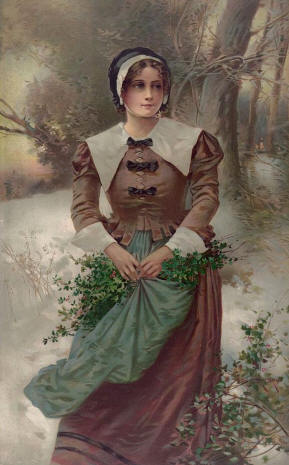
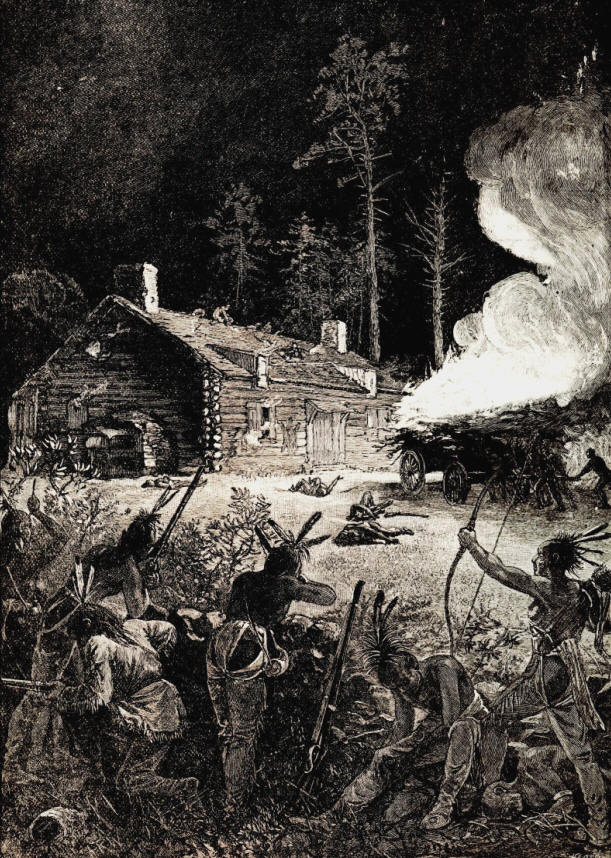
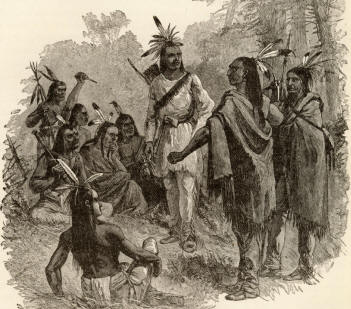 In
1609 the London Company succeeded in obtaining a new charter, by the
terms of which it organized as a stock company, with officers chosen
for life, a governor appointed by the Company's Council
in England, and a territory extending from the Atlantic to the
Pacific in a strip four hundred miles in width. During the interval
between the granting of the charter and the organization of the new
government anarchy reigned in Virginia. Smith did everything
possible to restore order, but was at last wounded by an accidental
explosion of powder and forced to return to England. At this time
In
1609 the London Company succeeded in obtaining a new charter, by the
terms of which it organized as a stock company, with officers chosen
for life, a governor appointed by the Company's Council
in England, and a territory extending from the Atlantic to the
Pacific in a strip four hundred miles in width. During the interval
between the granting of the charter and the organization of the new
government anarchy reigned in Virginia. Smith did everything
possible to restore order, but was at last wounded by an accidental
explosion of powder and forced to return to England. At this time
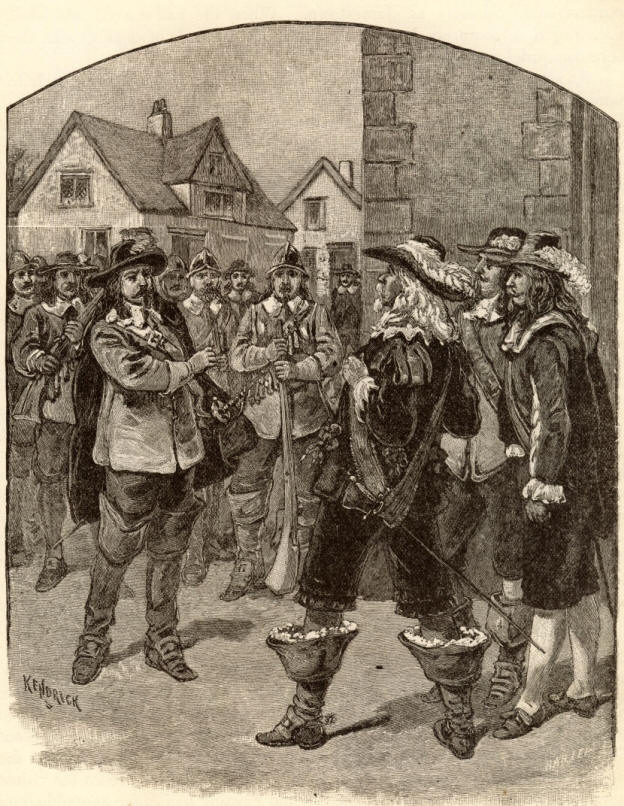
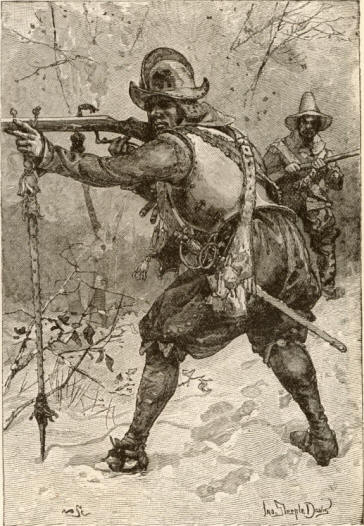 Of
the hundred souls left in Plymouth only fifty per cent remained
alive when the supplies from England came, a year later. Scurvy,
famine and exposure to the severe climate had killed most of the
weakest of them. Not a household but had suffered loss. Yet not one
offered to go back. Men and women alike stood to their posts with a
heroism that has never been excelled in the world's history. We read
how they planted their corn in the graveyard when planting time
came, so that the Indians might not discover the greatness of their
loss.
Of
the hundred souls left in Plymouth only fifty per cent remained
alive when the supplies from England came, a year later. Scurvy,
famine and exposure to the severe climate had killed most of the
weakest of them. Not a household but had suffered loss. Yet not one
offered to go back. Men and women alike stood to their posts with a
heroism that has never been excelled in the world's history. We read
how they planted their corn in the graveyard when planting time
came, so that the Indians might not discover the greatness of their
loss. 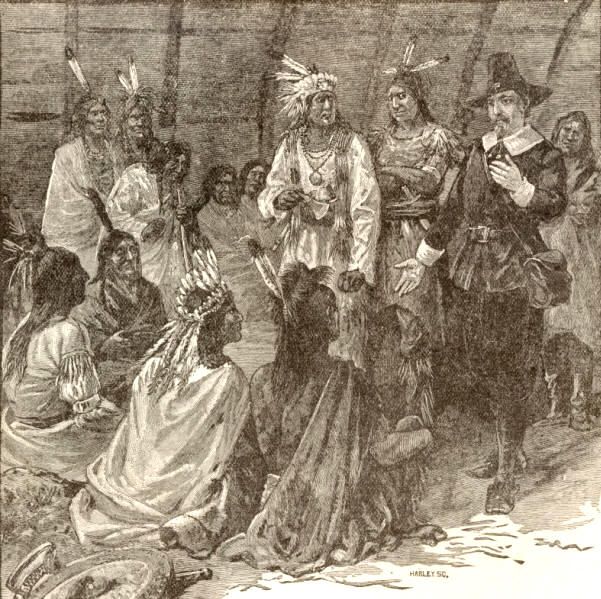
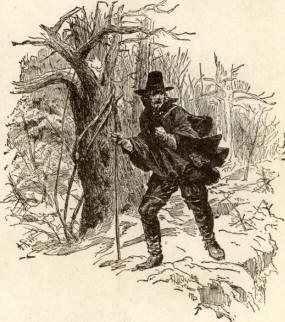 As
the Massachusetts colonies grew they excited the jealousy or
animosity of two very different classes of people. These were their
Dutch neighbors and the Indians. The most serious of the early
difficulties with the aborigines was, in fact, the effect of Dutch
interference. These people had purchased the Connecticut river lands
from the Pequots. The Pequots only held the territory by usurpation
and the original owners obtained the Puritan protection, giving them
a rival title. The enraged Pequots commenced hostilities which were
promptly resented by the Puritan Governor, Endicott, who led his men
into the Indian country, punishing the assailants severely. This
act, however necessary it may have been, laid the colony open to all
the cruelty of a long-continued war, which lasted until the final
remnant of the Pequot tribe had been extinguished.
As
the Massachusetts colonies grew they excited the jealousy or
animosity of two very different classes of people. These were their
Dutch neighbors and the Indians. The most serious of the early
difficulties with the aborigines was, in fact, the effect of Dutch
interference. These people had purchased the Connecticut river lands
from the Pequots. The Pequots only held the territory by usurpation
and the original owners obtained the Puritan protection, giving them
a rival title. The enraged Pequots commenced hostilities which were
promptly resented by the Puritan Governor, Endicott, who led his men
into the Indian country, punishing the assailants severely. This
act, however necessary it may have been, laid the colony open to all
the cruelty of a long-continued war, which lasted until the final
remnant of the Pequot tribe had been extinguished. 